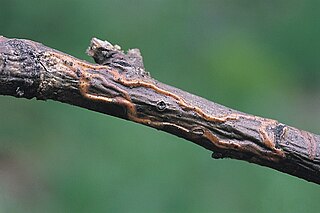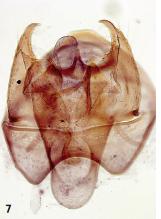
Nepticuloidea is a superfamily of usually very small monotrysian moths that are characterised by small or large eyecaps over the compound eyes. It comprises two families, the "pigmy moths" (Nepticulidae), with 12 genera which are very diverse worldwide and are usually leaf miners, and the "white eyecap moths" (Opostegidae), also worldwide but with five genera and about a ninth as many species, whose biology is less well known.

Nepticulidae is a family of very small moths with a worldwide distribution. They are characterised by eyecaps over the eyes. These pigmy moths or midget moths, as they are commonly known, include the smallest of all living moths, with a wingspan that can be as little as 3 mm in the case of the European pigmy sorrel moth, but more usually 3.5–10 mm. The wings of adult moths are narrow and lanceolate, sometimes with metallic markings, and with the venation very simplified compared to most other moths.
Scythropiodes is a genus of moth in the family Lecithoceridae.
Sindicola is a genus of moth in the family Cosmopterigidae.

Ectoedemia atrifrontella is a moth of the family Nepticulidae. It is found in most of Europe except Iceland, Ireland, Belgium and most of the Balkan Peninsula. It is also present in the Near East.
Ectoedemia longicaudella is a moth of the family Nepticulidae. It is found from most of Europe, east to Belgorod and Kaluga in Russia. It is also present in the Near East.

Ectoedemia amani is a moth of the family Nepticulidae. It is found in southern Norway, southern Sweden, Denmark, Austria, and Macedonia.

Bohemannia is a genus of moths of the family Nepticulidae.
Bohemannia auriciliella is a moth of the family Nepticulidae. It has been recorded from Great Britain, the Netherlands, France and the Czech Republic.
Bohemannia pulverosella is a moth of the family Nepticulidae. It is found from Fennoscandia to the Iberian Peninsula, the Alps, Slovenia and Bulgaria and from Ireland to central Russia and Ukraine.

Bohemannia quadrimaculella is a moth of the family Nepticulidae. It is found from Norway and Sweden, south to France and from Ireland, east to the Czech Republic and Austria. It has also been recorded from Romania.
Bohemannia manschurella is a moth of the family Nepticulidae. It was described by Puplesis in 1984. It is known from the Russian Far East and Japan.
Bohemannia nubila is a moth of the family Nepticulidae. It was described by Puplesis in 1985. It is known from the Russian Far East, Korea and Japan.
Bohemannia suiphunella is a moth of the family Nepticulidae. It was described by R.K. Puplesis in 1984. It is known from the Russian Far East.
Bohemannia piotra is a moth of the family Nepticulidae. It is found in the Russian Far East.
Bohemannia nipponicella is a moth of the family Nepticulidae. It was described by Hirano in 2010. It is known from Japan (Honshū).
Scythropiodes ussuriella is a moth in the family Lecithoceridae. It was described by Alexandr L. Lvovsky in 1996. It is found in Korea and the Russian Far East.
Martyringa ussuriella is a moth in the family Lecithoceridae. It was described by Alexandr L. Lvovsky in 1979. It is found in Russia (Ussuri) and Japan.
Piotra or Pyotra may refer to:


